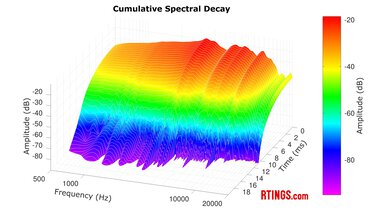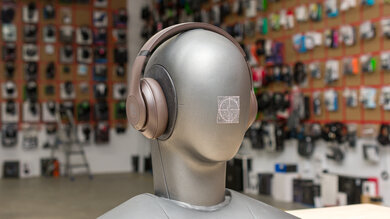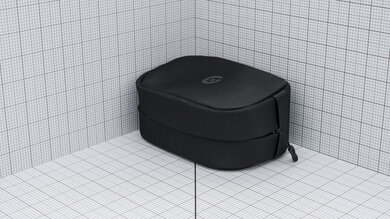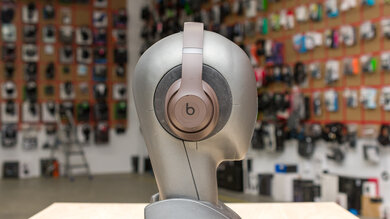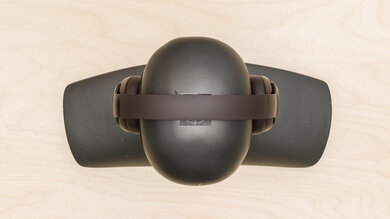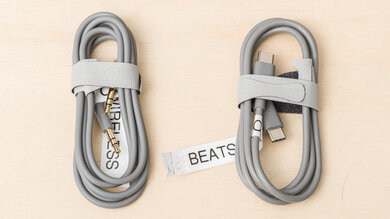The Beats Studio Pro Wireless are over-ear headphones with an active noise cancelling (ANC) feature. They have a similar look to the Beats Studio3 Wireless, but unlike previous models, they support audio via USB-C and have a built-in digital-to-analog converter (DAC), which lets you stream higher-quality audio via USB-C compared to Bluetooth. Connecting through USB-C gives you access to EQ presets, which is quite unusual for Beats, as they typically don't have sound customization features. They also come equipped with Spatial Audio for virtual surround sound. Unlike other Beats headphones, such as the Beats Solo Pro, they don't have an H1 or W1 chip, but they support One-Touch Pairing with iOS devices and Google Fast Pair with Android phones.
Our Verdict
The Beats Studio Pro are decent for sports and fitness. These wireless headphones are well-built and have good controls that let you adjust your music without using your phone. They're stable enough to stay in place during moderate workouts, like a jog in the park or some low-intensity exercises, but might slip out of place if you make sudden, intense movements. Like most over-ear headphones, they also lack an IP rating for water resistance.
-
Very good full-range noise isolation performance.
-
Long battery life.
-
Good build quality
-
Can slip out of place with intense movements.
-
Limited sound customization features.
-
No IP rating.
The Beats Studio Pro are good for commuting and traveling. They have a sturdy build quality and a long, continuous battery life for long rides or flights. Their ANC blocks out a good amount of noise in environments like airplane cabins and busy streets but struggles slightly in office environments. Unlike similar models, such as the Beats Studio3 Wireless, they come with a soft carrying pouch instead of a sturdy case; however, they also aren't as comfortable for many people.
-
Very good full-range noise isolation performance.
-
Long battery life.
-
EQ presets available via USB-C.
-
Limited sound customization features.
The Beats Studio Pro are satisfactory for office use. Their battery lasts for around 28 hours of continuous use, so you don't have to worry about recharging daily. Plus, their ANC system does a decent job of cutting out the hustle and bustle of a busy office environment. However, they aren't ideal if you want very comfortable headphones for all-day use. They don't support multi-device pairing, so you must re-pair them when switching between your phone and computer.
-
Long battery life.
-
Sub-par mic performance.
The Beats Studio Pro aren't intended for wireless gaming. They only work wirelessly via Bluetooth, so they can't connect with PlayStation or Xbox consoles without a wire. They work with Bluetooth-enabled PCs but have high latency, so depending on your sensitivity, you can notice syncing issues between your game audio and video.
The Beats Studio Pro are adequate for wired gaming. They aren't intended for gaming, but their mic and audio work with PCs and PlayStation consoles via wired USB-C with low latency. If you like to feel a bit more rumble and boom from sound effects like explosions while dialogue and instruments are bright and sparkly, you'll like their sound. There are even a few EQ presets available for sound customization if you're connected via USB. However, they don't have a very good mic performance.
-
EQ presets available via USB-C.
-
Sub-par mic performance.
The Beats Studio Pro have good audio reproduction accuracy. Their response doesn't deviate much from their balanced sound profile, and they've a little extra boom and sparkle, which works nicely for contemporary pop music. That said, a few peaks and dips in the treble range can render sibilants dull or piercing, depending on their pitch. Their left and right drivers also deviate a bit in amplitude throughout the treble region, which can make voices sound slightly off-center.
The Beats Studio Pro noise cancelling performance is very good. They do an especially good job blocking out higher-pitched sounds like A/C whine. That said, they don't block out very bassy sounds like rumbly bus engines, and sounds like office chatter make it past the ANC system, so these aren't the best choice for office use.
The Beats Studio Pro have a disappointing microphone system. The mic makes your voice sound harsh and bright, and it also doesn't adequately separate your voice from any noise around you.
The Beats Studio Pro have okay frequency response consistency. Generally, your listening experience will align with our frequency response measurements, though you'll experience deviations in the bass range if you wear glasses or have long hair, as these features can disrupt the seal created by the earpads. We recommend taking the time to ensure a proper seal is achieved to ensure consistent audio delivery.
- 7.1 Sports And Fitness
- 7.6 Travel
- 6.9 Office Work
- 5.6 Wireless Gaming (In Development)
- 6.8 Wired Gaming (In Development)
Performance Usages
- 7.5 Audio Reproduction Accuracy
- 7.9 Noise Isolation
- 5.2 Microphone (In Development)
- 6.8 Frequency Response Consistency
Changelog
-
Updated Apr 25, 2025:
This review has been updated to Test Bench 2.0, which adds the following tests: Stereo Mismatch, Group Delay, Cumulative Spectral Decay, PRTF, Harmonic Distortion, and Electrical Aspects. We've added new performance usages and updated the text throughout the Sound tests and side-by-sides.
- Updated Apr 25, 2025: We've converted this review to Test Bench 2.0, which updates our sound tests and adds performance usages. You can read more about this in our changelog.
-
Updated Dec 05, 2024:
We've made minor edits to the text to improve clarity and mention firmware 2C301 adds support for Audio Sharing with compatible Apple devices.
- Updated Sep 12, 2024: The following test groups have been updated following Test Bench 1.8: Sound Profile, Raw Frequency Response, Mid-Range Profile: Target Compliance, Peaks/Dips. There have also been text changes made throughout the review, including to the product comparisons to match these results.
- Updated Sep 12, 2024: We've converted this review to Test Bench 1.8, which updates our target curve and Sound tests. You can read more about this in our changelog.
Check Price
Differences Between Sizes And Variants
The Beats Studio Pro are available in standard colors: 'Black,' 'Black/Gold,' 'Matte White,' 'Deep Brown,' 'Navy,' and 'Sandstone.' An additional three colors, 'Moon,' 'Dune,' and 'Earth,' are available for the Beats Studio Pro x Kim Kardashian edition. Our unit is 'Deep Brown.' If you're interested, you can view their label. We expect our results to be valid for the other variants as well.
If you encounter another variant, let us know in the comments, and we'll update our review.
Compared To Other Headphones
The Beats Studio Pro have a similar design to previous 'Studio' headphones from Beats, including the Beats Studio Wireless and the Beats Studio3 Wireless. However, the Studio Pro differ in some major ways. They have less rumble, punch, and boom, which is a drawback if you prefer more bass in your audio. They also support a wired connection via USB-C, giving you access to a few EQ presets for sound customization. Their ANC feature blocks out a good amount of noise across the full range, but it doesn't fare as well in common scenarios when compared with other premium ANC headphones like the Bose QuietComfort Ultra Headphones Wireless or the Sony WH-1000XM4 Wireless. That said, the Beats are much cheaper than either the Sony or Bose. If you're here because of Beats' reputation for bass-heavy headphones but your budget can't stretch to those, consider the Sony ULT WEAR, which have loads of bass on tap and are more affordable than the brand's flagship models.
If you're looking for more headphones, check out the best over-ear headphones, the best noise cancelling headphones, and the best headphones for music.
The Bose QuietComfort Ultra Headphones Wireless are better than the Beats Studio Pro Wireless. The Bose have a more comfortable fit and a better build quality. Their ANC feature blocks out more noise across the entire range, and they have a better app with sound customization features. However, the Beats can connect via USB-C, which gives them lower latency than a Bluetooth connection and lets you connect to PlayStation consoles with full mic and audio support.
The Sony WH-1000XM5 Wireless are better than the Beats Studio Pro Wireless. The Sony have a better ANC and mic performance and offer in-app sound customization. They also support multi-device pairing. However, the Beats are fully compatible with PlayStation consoles with their USB-C cable. They have quick-pairing features with iOS and Android devices, while the Sony only support quick pairing with Android.
The Sony WH-1000XM4 Wireless are better than the Beats Studio Pro Wireless for most purposes. The Sony's ANC feature blocks out more noise across the entire range. They're more comfortable for most, have a longer battery life, and offer more robust sound customization features. However, the Beats support audio via USB-C, which lets you stream high-fidelity audio and use the headphones while charging.
The Beats Studio Pro Wireless and the Apple AirPods Max have a few things in common, especially as Beats was acquired by Apple in 2014. Still, if you're looking for a premium product, you'll want to check out the AirPods Max. These headphones are better built, have a much better full-range noise isolation performance, and have an H1 chip, so you can seamlessly pair them with your iOS devices. However, the Beats have a better overall battery performance, and you can use them via analog or wired USB-C.
The Beats Studio Pro Wireless are the over-ear counterpart of the Beats Solo 4, which are on-ear headphones. Both have a similar sound, but only the Studio Pro have a couple of EQ presets when using their built-in DAC via USB. The Studio Pro also have noise cancelling and can block out a good amount of ambient sound so that you can focus on your audio. However, the Solo 4 are cheaper and offer similar levels of comfort and build quality.
The Bose QuietComfort Headphones Wireless are better than the Beats Studio Pro Wireless in most ways. The Bose have a more comfortable fit and ANC performance. They also have a better microphone, which you can use with both Xbox and PlayStation consoles. The Beats, however, support Spatial Audio with head tracking to create a more immersive listening experience.
The Beats Studio Pro Wireless are better than the Beats Studio3 Wireless. The Pro's ANC feature blocks out more noise. They have a somewhat longer battery life, and there are a few EQ presets for sound customization when connected via USB-C. They also support virtual surround sound and NFC pairing. However, the Studio3 have a much more comfortable fit for most people. They also have a more protective case and a W1 chip that allows faster pairing with iOS devices.
The Bose QuietComfort 45/QC45 Wireless are better than the Beats Studio Pro Wireless. The Bose can block out more noise across the range and have a more comfortable fit for most people. They support multi-device pairing and give you more control over the sound profile with an in-app graphic EQ. However, the Beats have a longer continuous battery life, and they support NFC and Google Fast Pair for quicker pairing with your devices.
The Beats Studio Pro Wireless are better than the Beats Solo3 2019. The Studio Pro are over-ear headphones with ANC, so they can block out much more ambient sound. They work via Bluetooth, USB, and analog, so they're compatible with gaming consoles as well as phones and computers. On the other hand, you might prefer the Solo3's on-ear fit. They have a more bass-heavy sound profile, which you might prefer, especially for genres like EDM or hip-hop.
The Beats Studio Pro Wireless are better than the Beats Studio Wireless. The Studio Pro's ANC feature is more effective, and they have a longer continuous battery life. They have a virtual surround sound feature and support USB-C audio. However, the Studio Wireless have a more comfortable fit for most people.
Test Results
Their sound profile is balanced with a slightly emphasized treble. Our results reflect the headphones' performance when connected via Bluetooth. Sadly, they don't have sound customization features when connected via Bluetooth or an analog cable.
You can also use the headphones via analog or USB-C. The headphones have a built-in DAC that lets you stream audio from your phone or computer via USB-C at higher fidelity than via Bluetooth. When connected that way, you can also choose from a few different EQ presets: 'Beats Signature,' which provides the most neutral sound, 'Entertainment,' which boosts the bass and treble, and 'Conversation,' which significantly reduces bass. You can see a comparison between each preset on this graph. Keep in mind that these EQ presets are only available via USB-C connection.
These headphones have okay frequency response consistency. They perform more consistently than the Beats Studio3 Wireless, but people who have longer hair might experience a small drop in bass, and people who wear glasses could experience a large drop in bass. That's because bass response requires that the earpads form a good seal with your head. In general, it's worth taking the time to adjust the headphones' seal and position on your head with each wear in order to achieve a consistent sound whenever you use the headphones.
They have outstanding compliance to our target curve in the bass range. The low-bass is slightly overemphasized, so your audio has extra thump. That said, the rest of the response is fairly close to our target, resulting in full-body and warm sound.
Their mid-range frequency response complies amazingly well with our target curve. The entire range is virtually flat apart from a slight elevation in high-mids that brings additional clarity and detail.
Target compliance in the treble range is outstanding. Instruments and lead vocals sound clear and detailed, so guitars, like those in the solo at the beginning of Metallica's song, Fade To Black, have definition and detail. However, some high-pitched percussive attacks can sound too bright.
The Beats Studio Pro have a great peaks and dips performance, meaning they don't deviate much from their balanced sound profile. The most pronounced deviations are in the treble range, where a series of peaks and dips can make sounds like cymbals alternately dull or piercing depending on their pitch.
These headphones have a decent stereo mismatch performance. There are some small discrepancies in amplitude between the left and right drivers in the bass and mid-range areas, but they're relatively minor and hard to notice with real-life content. However, bigger deviations in the treble range are noticeable and can cause sounds like vocals and cymbals to feel slightly pulled to one side. The phase response is well-matched, apart from a minor mismatch in the high-bass, which is audible with test tones, but hard to notice with regular content.
These headphones have a passable group delay performance. The group delay in the low-bass crosses the audibility threshold, so sounds like 808 kick drums can feel loose and flabby. There are no issues in the mid- and treble-ranges, though, so high percussion sounds crisp and clean.
The audio these headphones produce doesn't interact much with your outer ear, so they don't produce a very open or speaker-like soundstage. Similar headphones, like the Sony WH-1000XM5 Wireless, produce a more immersive soundstage.
These headphones have remarkably good distortion performance. You can blast your tunes at unsafe listening levels without fear of distorting your audio.
These headphones only work when switched on and active, so we didn't take impedance and sensitivity measurements.
These headphones support Spatial Audio, which includes 'Head Tracking' and 'Fixed' modes. Head Tracking will follow your movements and adjust the soundstage depending on your head position relative to your phone, while Fixed simulates regular surround sound. However, it only works with compatible content and might require a subscription.
Using Spatial Audio also seems to affect the headphones' maximum volume, but it's a minor difference. With Spatial Audio on, audio can get about one decibel louder. Here are the volume measurements when playing 'Pink Noise for Sleeping' from Apple Music, with Spatial Audio set to Off, Fixed, and Head Tracking.
- Off: 104.8 dB
- Fixed: 106.3 dB
- Head Tracking: 106.1 dB
These are the settings used to test the Beats Studio Pro. Our results are only valid when using them in this configuration.
The Beats Studio Pro have a sleek, rounded look, similar to the Beats Studio3 Wireless and the Beats Studio Wireless. The manufacturer's logo is on each ear cup. They come in a few standard edition colors like 'Black,' 'Black/Gold,' 'Matte White,' 'Deep Brown,' 'Navy,' and 'Sandstone,' as well as skin-tone collaboration colors for their Beats Studio Pro x Kim Kardashian special edition.
The Beats Studio Pro Wireless headphones have a decently comfortable fit for most people. The ear cushions have a plush feel but clamp onto your head quite securely, which can cause fatigue over time or discomfort if you have a larger head. The ear cups don't have much range of motion. They're also quite shallow, and your ears might rub against the drivers, which can be irritating. That said, people with smaller heads or ears may not be affected by these headphones' tighter fit and shallow cups. Regardless, like the Beats Studio3 Wireless, the headband could also use more cushioning and might cause soreness with prolonged use. If you're looking for more plush over-ears, consider the Shure AONIC 50 Gen 2 Wireless instead.
The Beats Studio Pro have good controls. They provide all the basic functions for controlling audio playback, phone calls, and switching between ANC and 'Transparency' mode, which lets you hear your surroundings without removing the headphones. There's no audio feedback when a command is registered, but the controls are all physical buttons that you can hear click. When connected via USB-C, ANC and 'Transparency' mode are disabled, but you can cycle between EQ presets with the power button. These EQs are only available when you're using the USB-C cable and are only accessible with the onboard controls. There are also volume controls, but you don't get an audio cue for reaching minimum or maximum volume. Below are the default controls on the Beats Studio Pro.
The 'b' button:
- Single press: Plays/pauses audio or answers/ends a call.
- Double press: Skips to the next track.
- Triple press: Skips to the previous track.
- Hold: Activates voice assistant.
The ring surrounding the 'b' button:
- Single press above the 'b' button: Raises the volume.
- Single press below the 'b' button: Lowers the volume.
The power button:
- Press and hold: Enters pairing mode.
- Double press: When connected via Bluetooth or analog, cycles between ANC on, off, and 'Transparency' mode. When connected via USB-C, it cycles between EQ presets.
Unlike previous versions of these headphones, including the Beats Studio3 Wireless and the Beats Studio Wireless, they come with a soft pouch instead of a hard case. This provides less protection against being dropped or crushed than a hardback case. However, the fabric is still quite thick, and the case zips closed to protect against dust and spills.
They have a good build quality. Like the Beats Solo 4, they're mostly made of sturdy-feeling plastic. However, the foldable hinges on the headband could degrade with use and stop snapping properly into position. Overall, the headphones feel somewhat stiff and creaky.
The Beats Studio Pro have a great noise isolation performance. Their ANC improves on the previous generation, the Beats Studio3 Wireless, by generally blocking out more noise. While they don't provide much attenuation against bass frequencies, they do a great job isolating you from higher-pitched noise like voices or computer fans. However, you can't use the ANC feature when you're using a wired USB connection.
These headphones have decent noise isolation performance in common scenarios. They're very good at cutting out the sound of airplane engines and perform similarly when you're on a busy street full of traffic. However, they don't isolate you from distraction quite as well in office environments.
Unlike other sounds, wind directly interacts with the ANC's microphones. Even though this sound doesn't reach your ears, the ANC system still tries to cancel it out, causing loud and unwanted noise. At the same time, the amount of wind noise can vary depending on the positioning of the mic and the headphone's design. Unfortunately, these headphones lack a wind reduction feature to help limit the annoyingness of this sound.
They have a great leakage performance. They leak some audio, mostly in the mid to treble ranges, but it's quieter than the noise floor of the average office. You can crank up the music in a moderately noisy environment without bothering anyone.
The mic seems to use an automatic compensation algorithm to adjust the gain. It appears to lower the gain in loud environments and increase the gain when it detects vocal frequencies. Pink noise (a kind of sound containing all frequencies) seems to cause the gain to lower significantly during our testing. That won't affect you during regular use, but it means your experience will be better than the score suggests.
The mic makes your voice sound bright but also hollow and lacking in body. The quality is inconsistent, so during a phone call, the quality can noticeably dip for a few seconds before recovering. The manufacturer advertises better call quality via USB-C. However, we found only a small improvement via USB-C if you're in a quiet area. You can listen to this recording of the microphone via USB-C and see this graph of the frequency response via USB-C.
The mic has a disappointing noise-handling performance. It can separate your voice somewhat from moderate noise, like at the office, but it'll still be audible in the background. With louder noise, like a train passing, your voice gets completely drowned out. Again, the manufacturer advertises a better mic performance via USB-C, and we didn't find much noticeable difference with that connection. You can listen to the mic's noise-handling performance via USB-C in these clips of speech with pink noise and with subway noise.
Their battery performance is excellent. The manufacturer advertises them to last 24 hours continuously with ANC or 'Transparency' mode on, and we measured a little over 28.5 hours with ANC on. The manufacturer advertises a 40-hour continuous battery life with both modes switched off. A 'Fast Fuel' feature also provides four hours of playback for 10 minutes of charging when the battery is low. Also, keep in mind that battery performance varies with use. They don't support passive playback via analog since they still need battery power to work, even if you plug them into an audio jack. You can charge the headphones and listen to music simultaneously with the USB-C cable.
The app is mediocre. It's simple to navigate as shown in this video, and the same features are available in the iOS and Android apps. You can adjust the ANC/Transparency controls (and remove one or the other from the onboard controls) and adjust the controls for ending calls (press or double-press). You can also set up personalized spatial audio and 'Find My Device,' and check the battery level. However, the app doesn't offer any sound customization features. You have access to a few EQ presets when connected by USB-C, but only via the onboard controls.
The Beats Studio Pro come with a 1/8" TRS cable that you can use to receive audio, but it doesn't work with the mic. However, this ensures that your audio is latency-free.
If you want to use the mic, you can also use the USB-C charging cable for a wired connection. Using the USB-C cable allows you to take advantage of their DAC and EQ presets. While their latency is higher via this connection than over analog, it's still low enough to keep audio and visuals in sync.
Unlike previous editions, like the Beats Studio3 Wireless, these headphones don't have a W1 or H1 chip for easier pairing and switching between iOS devices. However, they offer One-Touch Pairing with iOS devices, as well as Google Fast Pair, which similarly lets you quickly pair the headphones with Android devices. Unfortunately, they have high latency using the default SBC codec and don't support any other codecs that might lower it significantly. As a result, you may notice your audio and video slightly out of sync while gaming with these headphones connected via Bluetooth. However, different apps and devices can compensate for latency.
Their firmware 2C301 also introduces support for iOS' Audio Sharing feature on these headphones. It allows you to play your favorite tunes on the Studio Pro and a compatible audio device like the AirPods Pro (2nd generation) simultaneously when connected to the same source.
The Beats Studio Pro are fully compatible with PCs via wired USB or Bluetooth. You can also plug them in with the analog cable, but you can't use the mic that way.
These headphones have full mic and audio compatibility with PlayStation consoles via wired USB. You can also use the analog cable to receive audio if the headphones are charged.
The Beats Studio Pro are only compatible with Xbox consoles if you plug the analog cable into a controller. However, you can't use the mic that way, and the headphones still have to be charged since they won't work if the battery is dead.
Comments
Beats Studio Pro Wireless: Main Discussion
Let us know why you want us to review the product here, or encourage others to vote for this product.
Update: This review has been updated to Test Bench 2.0, which adds the following tests: Stereo Mismatch, Group Delay, Cumulative Spectral Decay, PRTF, Harmonic Distortion, and Electrical Aspects. We’ve added new performance usages and updated the text throughout the Soundtests and side-by-sides.
Update: We’ve made minor edits to the text to improve clarity and mention firmware 2C301 adds support for Audio Sharing with compatible Apple devices.


